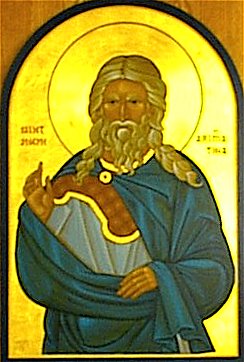| Joseph of Arimathea  Born: fl. 1st c. AD Born: fl. 1st c. AD
Died: fl. 1st c. AD
Cause of death: unspecified
Gender: Male
Religion: Christian
Race or Ethnicity: White
Occupation: Religion Nationality: Ancient Rome
Executive summary: Prepared Jesus Christ's cadaver In the New Testament, a wealthy Jew who had been converted by Jesus Christ. He is mentioned by the Four Evangelists, who are in substantial agreement concerning him: after the Crucifixion he went to Pilate and asked for the body of Jesus, subsequently prepared it for burial and laid it in a tomb. There are, however, minor differences in the accounts, which have given rise to controversy. Matthew (27:60) says that the tomb was Joseph's own; Mark (15:43 seq.), Luke (23:50 seq.) say nothing of this, while John (19:41) simply says that the body was laid in a sepulchre "nigh at hand." Both Mark and Luke say that Joseph was a "councillor", and the Gospel of Peter describes him as a "friend of Pilate and of the Lord." This last statement is probably a late invention, and there is considerable difficulty as to "councillor." That Joseph was a member of the Sanhedrin is improbable. Luke indeed, regarding him as such, says that he "had not consented to their counsel and deed", but Mark (14:64) says that all the Sanhedrin "condemned him to be worthy of death." Perhaps the phrase "noble councillor" is intended to imply merely a man of wealth and position. Again Matthew says that Joseph was a disciple, while Mark implies that he was not yet among the definite adherents of Christ, and John describes him as an adherent "secretly for fear of the Jews." Most likely he was a disciple, but belonged only to the wider circle of adherents. The account given in the Fourth Gospel suggests that the writer, faced with these various difficulties, assumed a double tradition: (1) that Joseph of Arimathea, a wealthy disciple, buried the body of Christ; (2) that the person in question was Joseph of Arimathea a "councillor", and solved the problem by substituting Nicodemus as the councillor; hence he describes both Joseph and Nicodemus (19:39) as cooperating in the burial. Some critics (e.g. David Friedrich Strauss, New Life of Jesus, ch. 96) have thrown doubt upon the story, regarding some of the details as invented to suit the prophecy in Isaiah 53:9, "they made his grave with the wicked, and with the rich in his death." But in the absence of any reference to this prophecy in the Gospels, this view is unconvincing, though the correspondence is remarkable.
The striking character of this single appearance of Joseph of Arimathea led to the rise of numerous legends. Thus William of Malmesbury says that he was sent to Britain by St. Philip, and, having received a small island in Somersetshire, there constructed "with twisted twigs" the first Christian church in Britain -- afterwards to become the Abbey of Glastonbury. The legend says that his staff, planted in the ground, became a thorn flowering twice a year. This tradition -- which is given only as such by Malmesbury himself -- is not confirmed, and there is no mention of it in either Gildas or Bede.
Biblical Figures
Converted to Christianity formerly Jewish
Canonization
Do you know something we don't?
Submit a correction or make a comment about this profile
Copyright ©2019 Soylent Communications
|